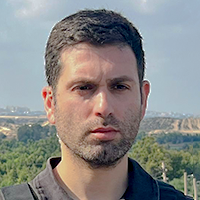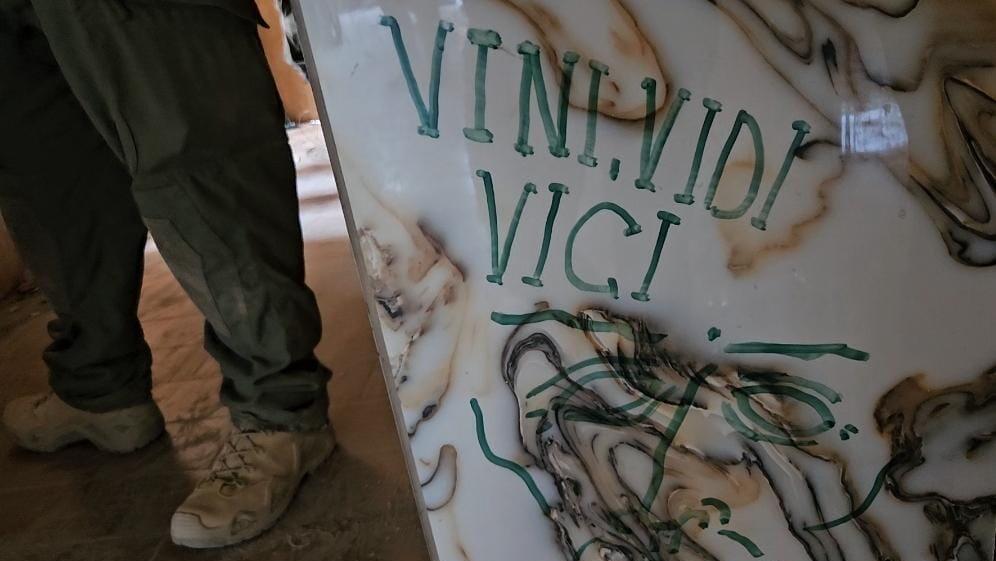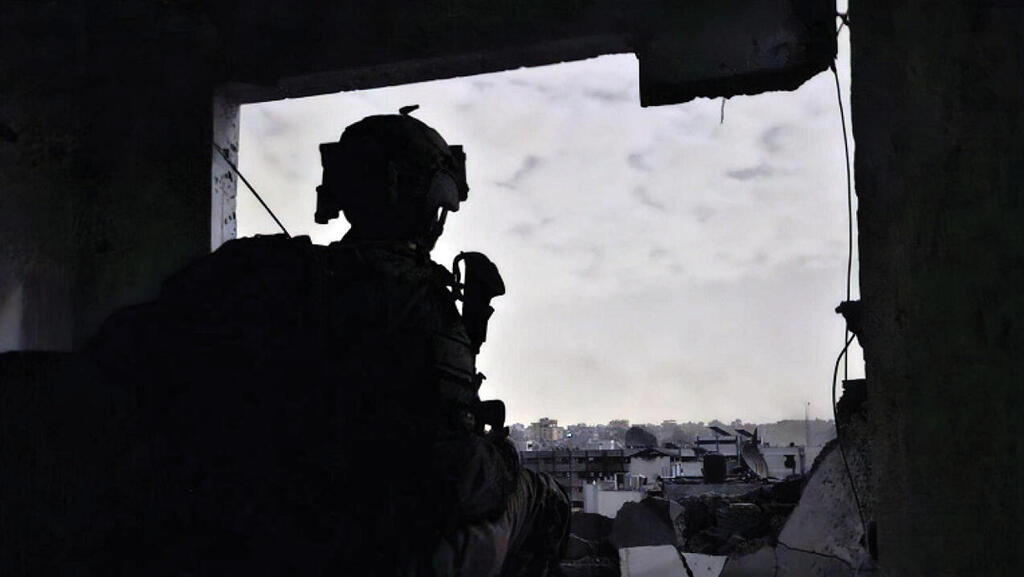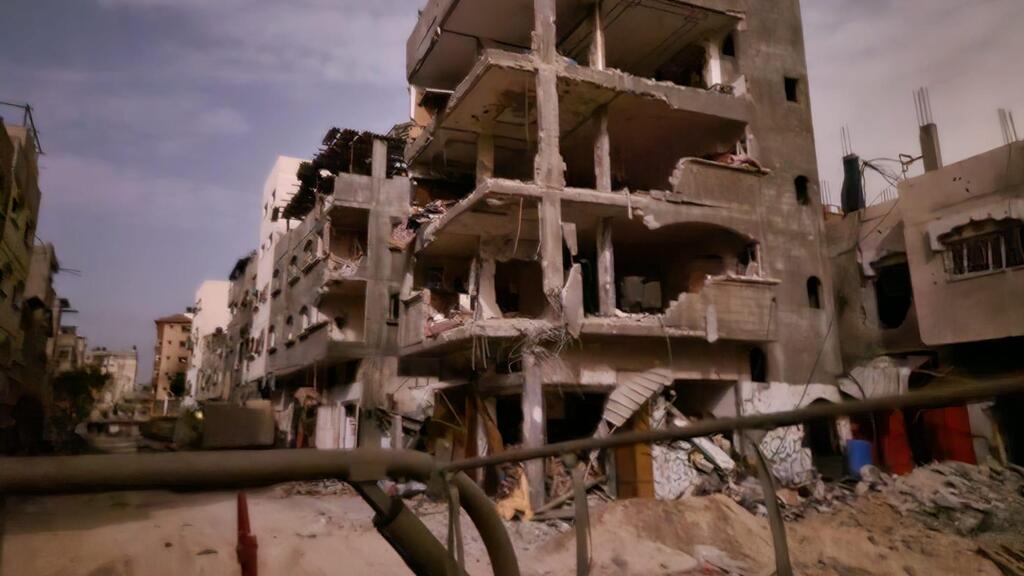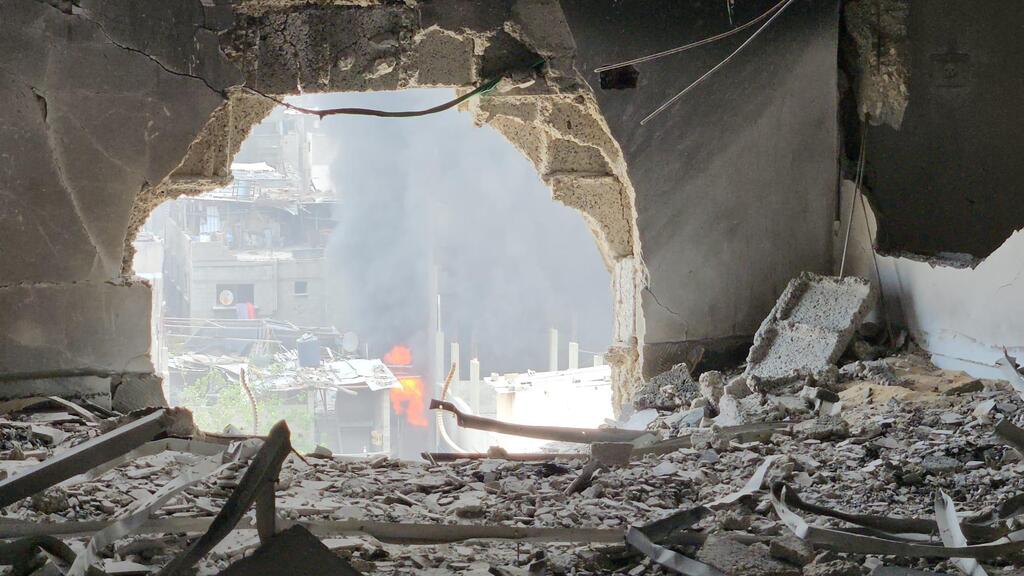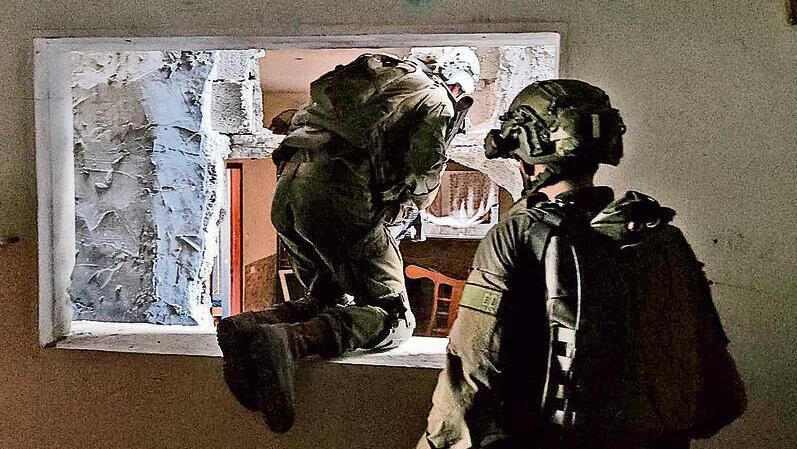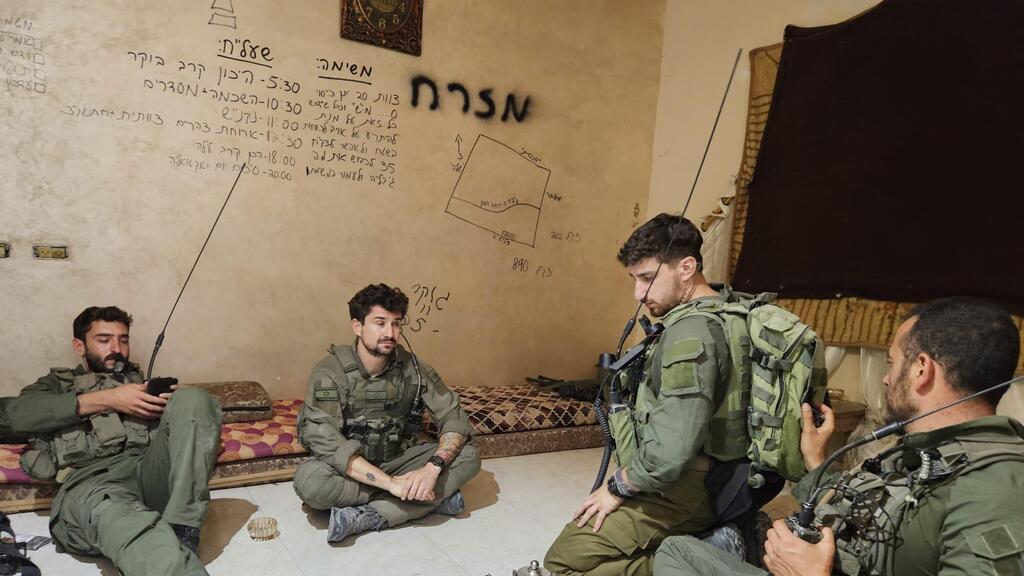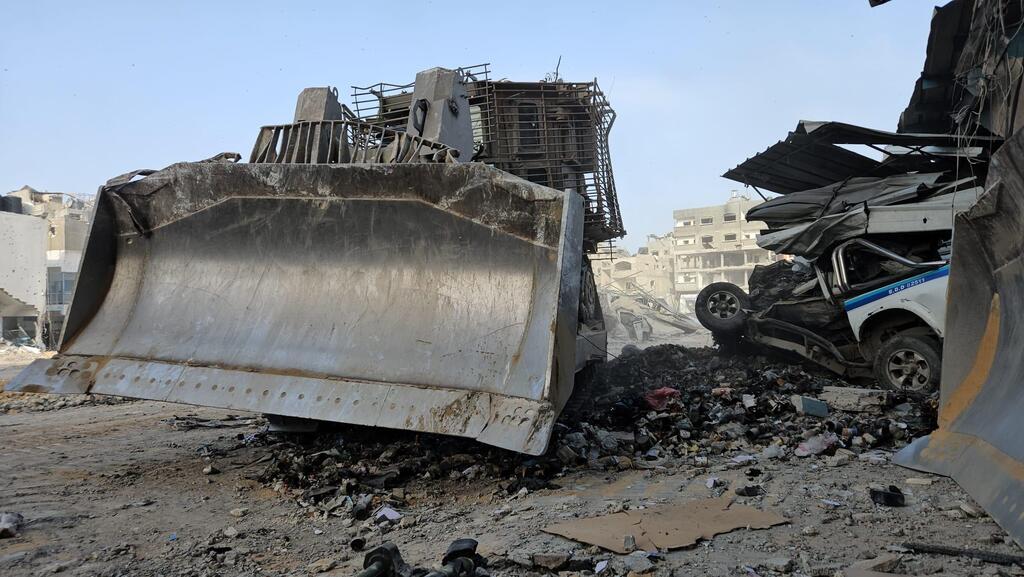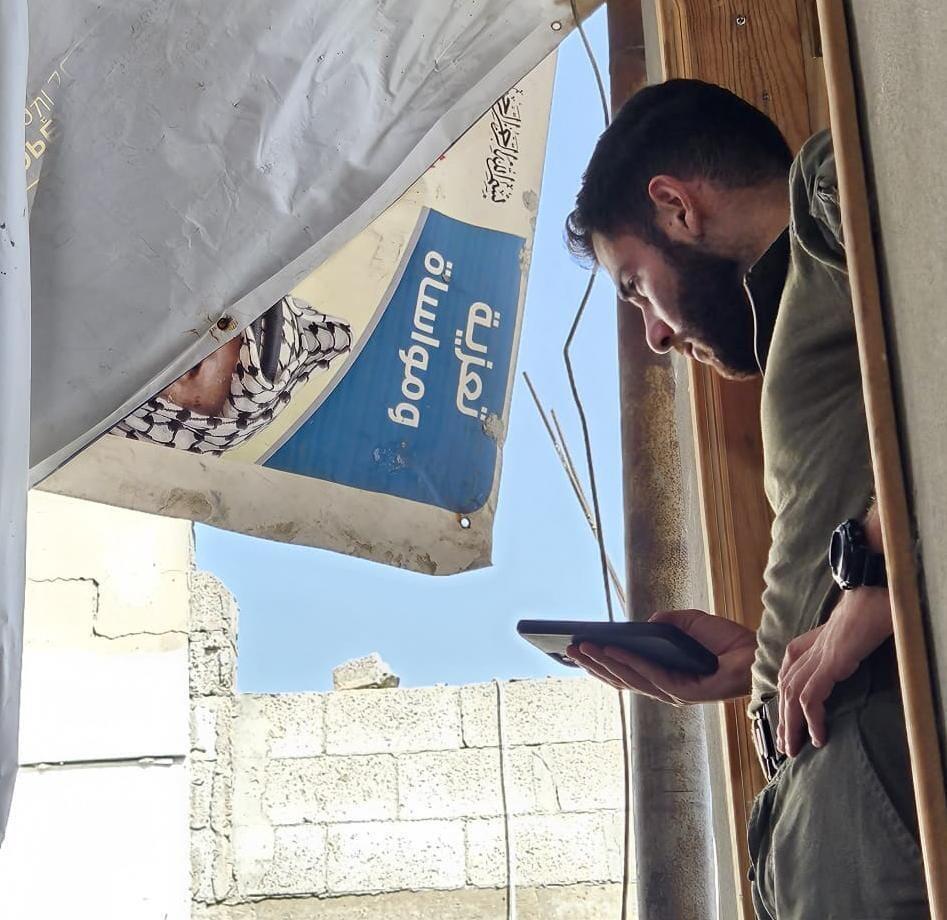Veni Vedi Vici. Julius Caesar’s famous three words are now daubed in green on a marble slab in the lobby of a nice-looking office building inside the Jabaliya refugee camp taken by the paratroopers.
“We’re only on the veni phase,” says one of the officers – the "we arrived" stage, before the "we saw," and certainly before "we conquered" the stage. This building is across from today’s target, the Palestinian Preventive Security (PSS) headquarters. The fighters are quick to plant explosive devices in the compound to blow it up.
The company’s commander, Maj. Daniel takes me to a spot in the headquarters’ corridors that shocked even him. And he’s seen a lot. He shows me a toddlers’ nursery with tiny little colored chairs, boxes of toys, and a blackboard decorated with drawings – in the heart of Hamas’s “Stasi” headquarters. “It would be like us setting up a kindergarten in the middle of a home base or next to, or inside, the Shin Bet headquarters,” he says.
And then it comes: Interspersed among all the booms around the neighborhood, mostly from the tank fire covering us, there’s one irregular boom. “Check out what that is” the company commander swiftly says. The chilling response was quick to come. A mortar had fallen 70 meters away from us during the critical minutes they attached the explosives. They quickly plant explosives in the compound. The company commander notices an IDF stretcher strewn on the ground and asks for it to be taken away, as it may be connected to the hostages and everything has to be checked.
It’s already 18:00 and before we find ourselves horribly trapped, we pack up and move to cover at the patrol commander’s nearby house before the blast hits. But before that, we take one last look at Jabaliya’s new market we’re crossing. The scent of spices still hangs in the air and rotting cucumbers are lying on the ground by the destroyed stalls. This civilian site has become a terrorist stronghold and the question remains as to whether it will revert to being as such when the paratroopers leave.
At 18:45 comes the pinnacle of the day’s battle as a huge blast shakes the Jabaliya refugee camp. Hamas’s general intelligence headquarters building blows up into the air, concrete parts flying hundreds of meters in all directions. The earth shakes as the sun begins to set in the west is covered with thick dust clouds.
The upscale refugee camp
The night before the operation’s completion, we were standing in the middle of what has come to be known as the “deputy battalion commander’s house.” The smell’s what hits you first - a particular combination of sour sweat, Marlboro Touch cigarette smoke and feces and urine remnants. Then you feel the heat. The bedroom in this house in the Jabaliya refugee camp is hot and steamy - much hotter than the actual 30°C (86°F) with 70% humidity when you sleep in full gear, socks and shoes. Add the mites,
mosquitos and sewage from downtown Jabaliya and this never-ending war’s summer season has kicked off. “It was more fun fighting in winter. It was great in Khan Younis back then,” recalls Sgt. Avraham Wanda from Or Yehudah as he begins his third watch guard duty at the living room listening position.
As in any neighborhood IDF ground operates, the water and electricity systems were cut off as soon as the Jabaliya refugee camp was occupied. We’re at the end of May and, only a few miles from the coast the soldiers are feeling the heat and humidity. The hygiene packs they received included mosquito repellent and antifungal foot powder. And these are essential.
Wanda lights up another cigarette from the packets he gets through each night. A landmark awaits him in the morning – the official end of training for the paratrooper’s commando unit. “I’ve been in the commando unit for a year and two months now.” He takes another drag. “At some point, they’ll even put on a ceremony and we’ll get our pins.”
The surrounding noise prevents neither him nor his friends from sleeping. “You get used to the explosions and you sleep deep,” says Wanda “I have dreams here, just like when I sleep at home. I’m also in touch with my parents and I tell them a lot about what we’re doing. It’s calms them down. Yes, you do smoke a lot here, so you roll your own cigarettes so it lasts longer.”
At 03:00, a cool breeze wafts in breaking the hot night. You can hear tank gunfire barrages two blocks away. You hear the mortar firing, and four seconds later you hear the mortar land here in the neighborhood. Abandoned Gazan dogs start barking from a nearby alleyway at varying decibels telling us that the dogs could sense something wasn’t right. But at 03:37, as I was drifting in and out of sleep, it was one explosion too many. The floor shaking from massive shockwaves that rocked the ground threw me off my mattress and onto the floor.
This was the IDF’s new ground bomb in Gaza, an unmanned D9 that tows an old M113 APC. This enormous bulldozer, jam-packed with tons of explosives and no soldiers in it places the suicide APC, knick-named a carcass, at a central intersection near the target the soldiers are to capture the following day. The APC is then blown up remotely and the walls of nearby houses crumble. The devices are activated with an impact as devastating as that of the IAF dropping tons of heavy bombs on the same spot at the same moment.
None of this bothered the six soldiers sleeping beside me in weird positions in the exposed room.
The H-20 (formerly Sabotage and Engineering Company) section commander, Maj. Daniel goes outside under the cover of the 04:00 darkness. Looking west, he and his men are just about to cross our forces’ lines of advance to a cluster of buildings not yet captured. Tomorrow, as the rest of the commando forces storm the target - Hamas’s general intelligence headquarters - his men will ambush terrorists trying to escape. This too, as it will turn out in two hours’ time, will be hard to implement. In the meantime, among the sounds of war, we hear the muezzin praying at a nearby mosque, a sound that’s become a rarity. This tells us that, unlike during the fighting at the height of the ground operations, this time around the IDF doesn’t control all of the surrounding neighborhoods and, among the rubble the IDF sowed in the ground operations, most of the sector’s tens of thousands of Gazans are trying return to normal life as best they can.
We reached Jabaliya, the Gaza Strip’s second largest city on the night of a full moon. We traveled donning goggles, with no headlights, but with a great deal of sand and dust. Sitting across from me in the hammer is the female deputy commander from the Administrative Assistance company who’s brought the men supplies for one more day of battle, along with a crate of ice pops to cool and sweeten the atmosphere.
She can’t provide the soldiers with hot food for fear of stomach complaints, so they’ve gotten used to cooking for themselves dry or canned food such as rice, lentils, or pasta in red sauce, reinforced with sausage meat and seasoned tuna in the kitchens of the homes they capture. “You know what the name Jabaliya means?” says a Unit 504 hostage investigator hitching a ride in the hammer to replace his friend operating with the paratroopers. “Jabaliya is a hill. The Arabs who came from Mount Hebron to live here a hundred years ago built a village that became a city in the Gaza Strip.”
When we reach the paratroopers’ post, we begin to understand the discrepancies between the narratives and actual reality. The IDF announced in December that Southern Command’s 162nd Division had completed its ground operations by defeating Hamas’ Jabaliya battalion and that the forces left had taken operational control of the city. What the IDF didn’t tell the public is that not a single soldier actually entered the hostile refugee camp, Hamas’s local stronghold, that has only now been dealt with by the paratroopers and the 7th Armored Brigade.
But the Palestinians also sell their own narratives. True, just 10cm separates one building from the next here, and there are alleyways and there was sewage in the street even before the IDF went in but, like Shati in the western part of Gaza City, this “refugee camp”, has been gentrified for some time and boasts large homes, eight and nine-story buildings, both a new and an old market by which we camp at night, and most importantly - a skilled Hamas force of hundreds of organized combatants in no hurry to flee.
“Hamas definitely controls and commands this area. They learned their lessons fighting us in the war’s first six months. They use organized cells and show a great deal of resistance, firing more than 100 anti-tank missiles at our tanks in the first days,” a commander tells me. “But we came stronger, more experienced, with more tricks up our sleeve and we go in quickly preventing lots of terrorists from escaping. Just today, we found four large explosive devices as big as this table. We know who Hamas’s battalion commander is here and what’s required of us.”
But even here, opinions vary. More junior commander I spoke to here in the field said that the refugee camp should have been closed off from all directions and the civilians leaving should have been screened like in Khan Younis four months ago. In practice, despite extraordinary resistance, hundreds of terrorists have nonetheless managed to escape the adjacent neighborhoods of Zeitoun and Daraj Tuffah which IDF will likely raid again later
At night we are much stronger than Hamas
Paratrooper commando deputy commander, Maj. Nadav, took three bullets to the chest and hand storming a terrorist cell in orchards north of Kibbutz Holit on October 7. His lungs were perforated, his internal organs were damaged, his spleen had gone and he was listed as one of the worst wounded that day. Maj. Nadav receives me at the Jabaliya refugee camp. He didn’t show me the scars on his stomach and modestly tells me that his friends here in the deputy battalion commander’s living room also bear scars from that day – and not the emotional kind.
“Shavit ben Moshe who fought with us got a message during the battle that his brother Ariel, a General Staff Reconnaissance Unit (Sayeret Matkal) commander, was killed in battle. I immediately told him to take my car, go to his family and get himself to the funeral. I thought he’d go, but when I saw him two hours later near Holit, he said he’d decided to stay and fight. Two hours later, he took part in evacuating me when I was seriously wounded, and then he was wounded himself.”
“These are the people we have here. They operated on me in the field and I was only evacuated to Soroka Hospital by helicopter two and a half hours later. It was actually rather funny fighting for my life in the field like that. I was in hospital for a month and I had another month of rehabilitation and I was straight back to Khan Younis. I didn’t think I’d be back so quickly, but I have an enormous sense of commitment to the country and to my soldiers. So many of the wounded here had all the best excuses to not return. It’s much more than physical scars. I assume there’s damage I’ll carry with me.”
How did your family take it when you returned to Gaza? You have a young son at home.
“It wasn’t easy, but they understand the emotional resilience needed in these times. We’re living through an event of historical, biblical proportions.”
The morning started in a slightly disappointing way. Maj. Daniel’s force returned sweating and panting from the ambush earlier than expected as the sun was starting to rise behind them between the refugee camp’s grey houses. They walk into the room with all their equipment on. There weren’t enough good shooting angles and other reasons brought them back to routine, straight to the sugarless coffee cooking on the finjan on the improvised stove in the home of the family that lived here until two weeks ago. One of the soldiers pulls out an “operations snack” – a small, flat slab of chocolate with a ten-year expiration date, slightly sweetening the bitter coffee. We’re not sure where the chocolate came from. Some say they found it in the food packages the Americans dropped everywhere. Others think it’s part of upgraded field rations.
Maj. Avital sips the coffee and passes on a bite of the weird chocolate and reminds me why, in the eighth month of fighting, most of the battles take place in daylight rather than at nighttime. They are usually even at set times – either in the early morning or the afternoon. We’re much stronger than Hamas at night, despite Hamas trying to fire at us at night in the beginning, including from this very building. It feels like Hamas still has command and control here. It’s resisting. That’s the main difference between the enemy here and when we were fighting them in other places.
"You must understand how it works: Hamas activists go into the displaced people’s camps, including into schools and they plan their battles against us there, among the civilians. It was also like this in the market before we captured it. Hamas really readied for battle among the market stalls where we found 60kg explosives. Hamas terrorists also eat the displaced people’s food. They set out to fighting positions in the houses here without weapons that are waiting for them, in an organized fashion, in rooms in houses here in the neighborhood.”
In Jabaliya, as in Zeitoun, the officers were amazed: Tons of food from aid shipments that Israel’s urging to send into the Gaza Strip in quantities as large as possible, have become Hamas “food storehouses” that Hamas not only manages and uses to control hundreds of thousands of civilians in each city, but firstly uses this food to feed the remaining Hamas militants. “I hope we finish up the mission here with the local Hamas battalion destroyed and we can go back to simpler missions,” says Maj. Avital.
You’ve been here for six months of never-ending warfare, after you personally experienced the events of October 7. How do you carry on taking it?
“I’d be lying if I said all the soldiers are equally strong, but the resilience they exhibit here is extraordinary. Eight months ago, it was clear why they do what they do – because of October 7. Everyone was pumped up and it diminishes over time and we need to constantly remind everyone. On the other hand, I keep discovering new things in my men when they go out on raids with courage and strength of spirit. They return to their positions from a day’s fighting as if it were the first day and know that everything rests on their shoulders. They’re alert and push themselves. They miss home and the vast majority understand how important the task is.”
“It’s easy for us in all this chaos because we’re fighting an enemy and we know what’s good and what isn’t and we don’t get involved in politics, but rather in just destroying the enemy,” says Maj. Nadav. “Each and every soldier has a fallen friend or relative and it always comes back to them. We got in here on Independence Day, which was very powerful after Memorial Day because, for the first time, we understood what it was like to have a fallen friend.”
A soldier overhearing this wanted to emphasize, “We’re the Jewish People. Israel can carry this, not for a month or two, but for 2000 years in exile, and before the Exile, and after the Holocaust, and for 70 years after that. It’s just one phase in the chain of generations that our generation has to go through so the next generation to live. It may take a month or two or a year or two. We’ll get through this phase if we’re strong and united. It all rests on the Jewish People’s strength and unity.”
"Seeing the images of the abduction of soldiers is reminder why we are here"
The mission’s target is Hamas’s general security headquarters, a hostile compound in the middle of the refugee camp. The terrorist army’s internal investigations unit operated in this two-story complex that also includes a basement floor. There are also prison cells next to torture chambers used for collaborators that the combat forces must capture today – and destroy.
But getting there takes us back to the past. Instead of walking along ruined streets, we make our way through large holes in the middle of house walls, a method devised by the paratroopers on the streets of Nablus to avoid exposure. It turns out, however, that it’s not the paratroopers who are responsible for most of these holes in the walls but rather the Hamas terrorists who, in addition to using the tunnels, cross from house to house via these holes. At one section, there’s a seventh-storey crossing point between two adjacent buildings. As we traverse the chasm, company commander Avital checks to make sure I don’t have a fear of heights.
Just before this, we met Maj. Ziv from the other paratrooper’s team joining the operation in an hours’ time. The company commander feels this is a good time to motivate his men for battle and remind them why they’re here. Whereas they scrawled graffiti with a Star of David and “7/10” on the walls of the deputy battalion commander’s house, here Maj. Ziv infuses his men with something else: He shows them the video of the female field observers broadcast the preceding evening in Israel. His signal operator, injured in one of the battles in Khan Younis and undergoing rehabilitation in Israel, had sent him the video clip. Ziv had made use of a few moments of reception on the roof to download the three horrific minutes onto his phone. Not everyone wanted to watch the video and he doesn’t force it. There are soldiers here who saw dreadful things on October 7.
9 View gallery
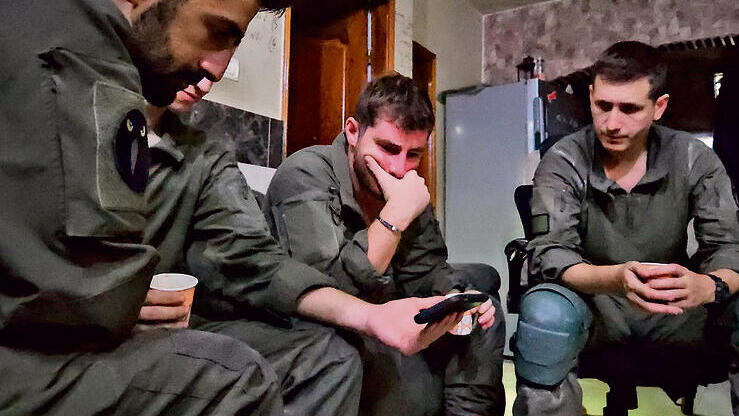

Troops watch video of the capture of IDF female soldiers on October 7
(Photo: Yoav Zitun)
“After watching the video, we can’t think of leaving when this is the situation and the hostages aren’t home,” Ziv says. “Everyone dreams of knowing they played a role in bringing back a hostage and these videos are a crazy reminder of why we’re still here. There are still lots of terrorists we haven’t gotten to yet and we keep being surprised by how many weapons they have left. It could go on for years. Watching this video is insanely frustrating.”
Does it make you ask yourself where you were and what you were doing 07:00-07:30 that Shabbat morning?
“At 06:45, I got a call from the late Guy Simchi, one of our soldiers who was at the Nova festival with CSM Harush. The terrorists had started shooting at them and they called to wake me up. I was the first person they called. I thought it was just rocket sirens and it would soon be over. I then heard rounds of gunfire in the background and I realized this was irregular. I told them to try and run to the nearest community and maybe take the security teams’ weapons and fight alongside them. I didn’t know they’d taken away the security teams’ weapons. We were home that Shabbat and all the soldiers’ guns were stored nearby. We drove to get the equipment and I left the house at 07:30. The patrol commander then called me and said ‘We’re under returning the situation to its previous situation (procedure)’.” (military code for Israeli conquest of enemy territory, a concept not used for decades).
“I’m familiar with the concept of ‘returning the situation to its previous situation’ from other places altogether. It means reconquering territory conquered from our territory when the defense had dropped. We drove at 190km in my car with rockets falling next to us on Route 6. I got there as fast as I could. Now, watching the video, I feel we got there too late. “
One of his men who caught his eye as he was watching the video with his three friends on the sofa in the house that they’d conquered in Jabaliya said, “Watching the video is shit. Personally, I don’t like seeing this stuff. It takes me back to where I was at 07:00 and 07:30 as we were preparing to go to the Gaza border region.”
A sneaky little drone
To get to Hamas’s general security headquarters, they need to conquer two streets with tall buildings and narrow alleyways full of terrorists and areas of explosives that you can’t see. They put me at the back, directly in the front line of fire in a nine-story building. It’s 10:00 and the sun’s already gleaming. Commander Lt. Col. Amit Madelsi’s cool composure imposes control and imparts confidence to the soldiers. They need to act wisely, advancing with force, but not rushing anywhere. The most important thing is not becoming exposed to Hamas snipers.
Hamas snipers are equipped not only with Russian Dragunov rifles with 7.62 mm bullets but also, as the IDF has learned, with large Barrett rifles with 0.5mm bullets. This is a heavy machine gun banned for sniping by the IDF decades ago as it can tear a body in two and, if hit at a certain angle, blow apart a head. Madelsi defines the part adjacent to the room’s windows facing attack as a destruction area and instructs the holding force team to maintain ongoing gunfire.
There is a “weapons economy” in place and they don’t shoot at the arbitrary volume they did at the beginning of ground operations. “Even then, we weren’t being wasteful. We always operated wisely,” the commander tells me.
In the room where the snipers are stationed, I find the platoon sergeant directing his men. Within the hour, they detect and take down two terrorists. “The snipers here kill the most. Dozens. The record holder in the next building killed a terrorist from 1,250 meters” the sergeant tells me proudly.
The greatest fear is anti-tank missiles fired at the building, so one of the doctors berates three soldiers resting a few moments on a sofa in a back room in an apartment out of which there’s fighting. “You don’t want Gaza to be the last thing you see.”
This is what the Indoor is for. This is what the army calls one of the smallest and sneakiest drones. It’s the size of a palm, quiet and almost undetectable and is operated using a monitor and a handy little joystick. This is how the tiny little Indoor is sent mainly into buildings, tunnels and closed rooms - with the operator hidden away in the dark not being exposed,
Patrol commander Madelsi instructs the men trained to operate the Indoor to send it into the next building. The drone starts surveying the house, beginning on the ground floor. Lieut. Col. Madelsi watches the live pictures on his little monitor and directs the drone operator beside him. “Stop, there’s an EFP (Explosively Formed Penetrator) there,” he says referring to an explosive device and instructing the operator to follow the wiring. Maneuvering the drone inside a house being shelled by tanks is no easy task.
The patrol commander’s gut feeling wasn’t wrong. The EFP had concealed wiring connecting it to further devices in the adjacent rooms. If we’d gone in, we may have found ourselves operating in a volatile zone. “It’s an important building that controls the sector. The Hamas booby-trapped it for good reason” he says. “I also noticed that two of the doors are locked, so there are probably terrorists hiding in there.”
The end of the little drone’s survey is no less amazing. The operator brings the drone back from the target building using the joystick and monitor via the courtyard with the fighting between us and the tanks, brings it up through the window of our room on the seventh floor, straight into the soldiers’ hands – without moving.
Patrol commander Mendelsi’s 20-year-old signal operator Sgt. Yair is given a mission by his commander. He’s told to take me, accompanied by three more soldiers, to Lieut. Col. Yoni HaCohen, commander of the 890th Battalion in his “house” two blocks away. It should be easy to navigate across 150 meters. It's not so easy in the midst of afternoon urban warfare with bullets whistling by and munitions shells flying everywhere. “How come you’re not in uniform? Aren’t you afraid?” And they’re not asking because of the surrounding enemy.
In battalion attacks such as this, anyone in civilian clothing, and more so today, wearing a black helmet and a bulletproof vest is a terrorist. So, I do my best to do my running in the exposed areas in the streets between the fighting – and not in any other streets. “Look, it’s really a breakthrough,” Yair says proudly, pulling an operations smartphone out of his pocket as we stop, kneeling down in a broad alley between two buildings. “This is the pocketknife – a computerized map that also shows where our forces are. Instead of telling forces to watch the orange building with the orange balcony, we open up this program and each building has a four-digit number. This is how we’ll get you to Lieut. Col. Yoni, the 890th Battalion commander.”
I first met Lieut. Col, Yoni, commander of the 890th Battalion on the fourth eve of the war in the inferno that was Kibbutz Be’eri. He’d been fighting since the early afternoon of October 7 and his eye was watering uncontrollably after being hit with shrapnel in the battles between the kibbutz houses shelled by tanks and anti-tank missiles, soaked in the stench of dead bodies.
Yoni isn’t just killing terrorists. He’s also demolishing their homes. We’re sitting in the house they took over at the start of operations here. The red telephone is sitting on the table as if we’re in his office at the base at Beit Lid. “Now, let’s watch TV,” he says. For a moment, it feels like Friday afternoon’s Arabic movie time with the family and sunflower seeds, but the countdown on the signal operator’s network brings us back to reality. The drone over the neighborhood projects a building in which three Hamas operatives were living onto the monitor. Two seconds later and the curtain covering the window behind me goes flying due to enemy sniper fire. The fallout from 100 meters away did its job.
Yoni is proud of his soldiers and he takes care of them, especially two groups: The medics often exposed to harsh sights of wounded, and his snipers who, through their target finders, see the results of their shooting. “One of my groups saves lives and the other kills terrorists and both of these groups get a two-day workshop about how to deal with it, to keep them emotionally strong – in addition to the processing we do for everyone when there’s a lull in the fighting.”
Just before we leave to return to Israel, the reservists give a mature, almost fatherly, take on the situation. At the start of the war, they took full advantage of the entrepreneurial spirit they’d brought from civilian life, bringing in special drones from donations, bypassing IDF bureaucracy, thus helping to quickly kill hundreds of terrorists. Today, they hold Jabaliya from the air with drones operating around the clock and are pleased to finally get drones that drop munitions.
Like other reservist combat units, out of nowhere, in the middle of their regular lives, they also put in reserve duty days, fighting with unprecedented continuity. “This time, we’re at 60% of the men who reported for duty at the beginning of the war,” says company commander Maj. Or. “Reservists aren’t a never-ending resource. Everyone here is giving 400%. Some of the wives are pushing down on the breaks. Some have threatened to break up and others have already gotten divorced. Wives and girlfriends are collapsing under the stress, developing serious psychological responses – things that a massage or a weekend in a bed and breakfast we got from the state can’t fix.”
Everyone here gives their all. As for those who couldn’t make it – it’s not about any kind of revolt. Hardships dealing with the discrepancies that have come about in our lives is a given situation” adds Maj. Or. “Everyone here has a story. One guy left Shijaiyah when his son was born, and he has another small child at home anyway. After months of reserve duty, both of us returned to offices that had closed. I was on a round raising investment funds for a startup I’d developed. I missed it. It’s gone.”
After 24 hours of fighting, we leave Jabaliya. The last of the soldiers pulled out last Thursday, completing three weeks of the IDF’s first operation in the Jabaliya refugee camp. Ten soldiers were killed in the operation, the bodies of seven hostages were brought home and the forces killed hundreds of terrorists and detected and destroyed 10 km of tunnels, some close to Israel.
One thing’s clear to all the soldiers: They’ll soon have to go back there.



